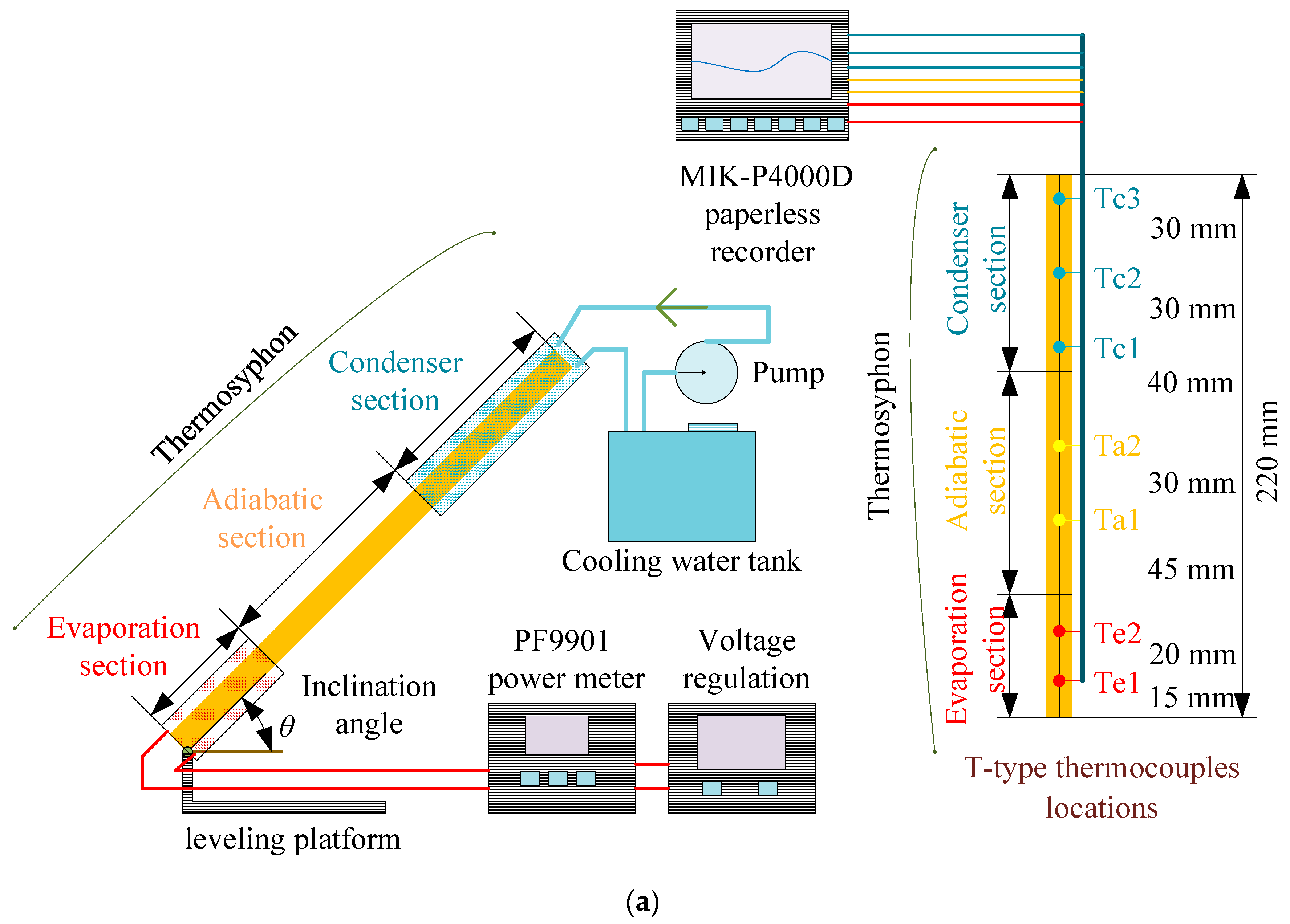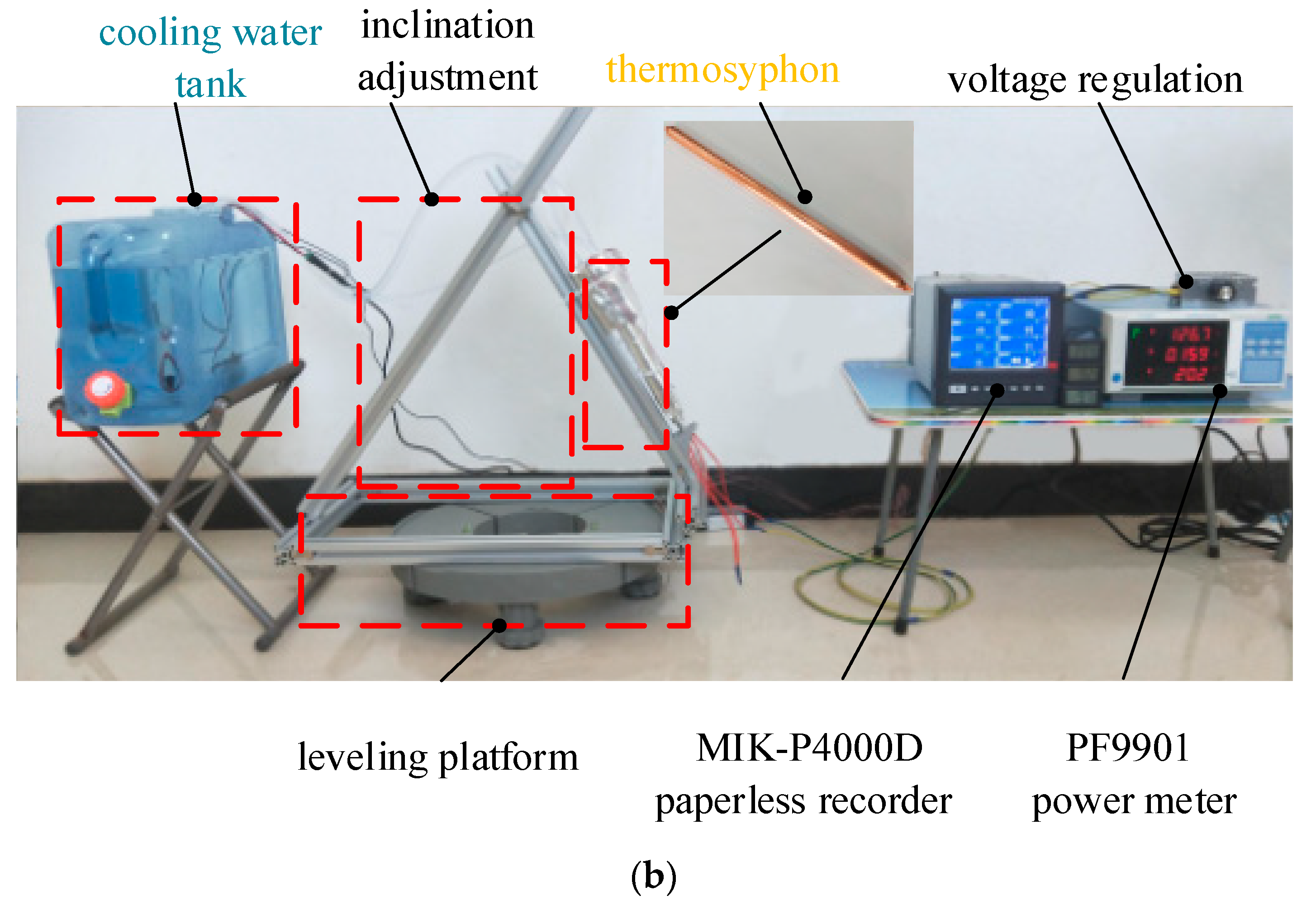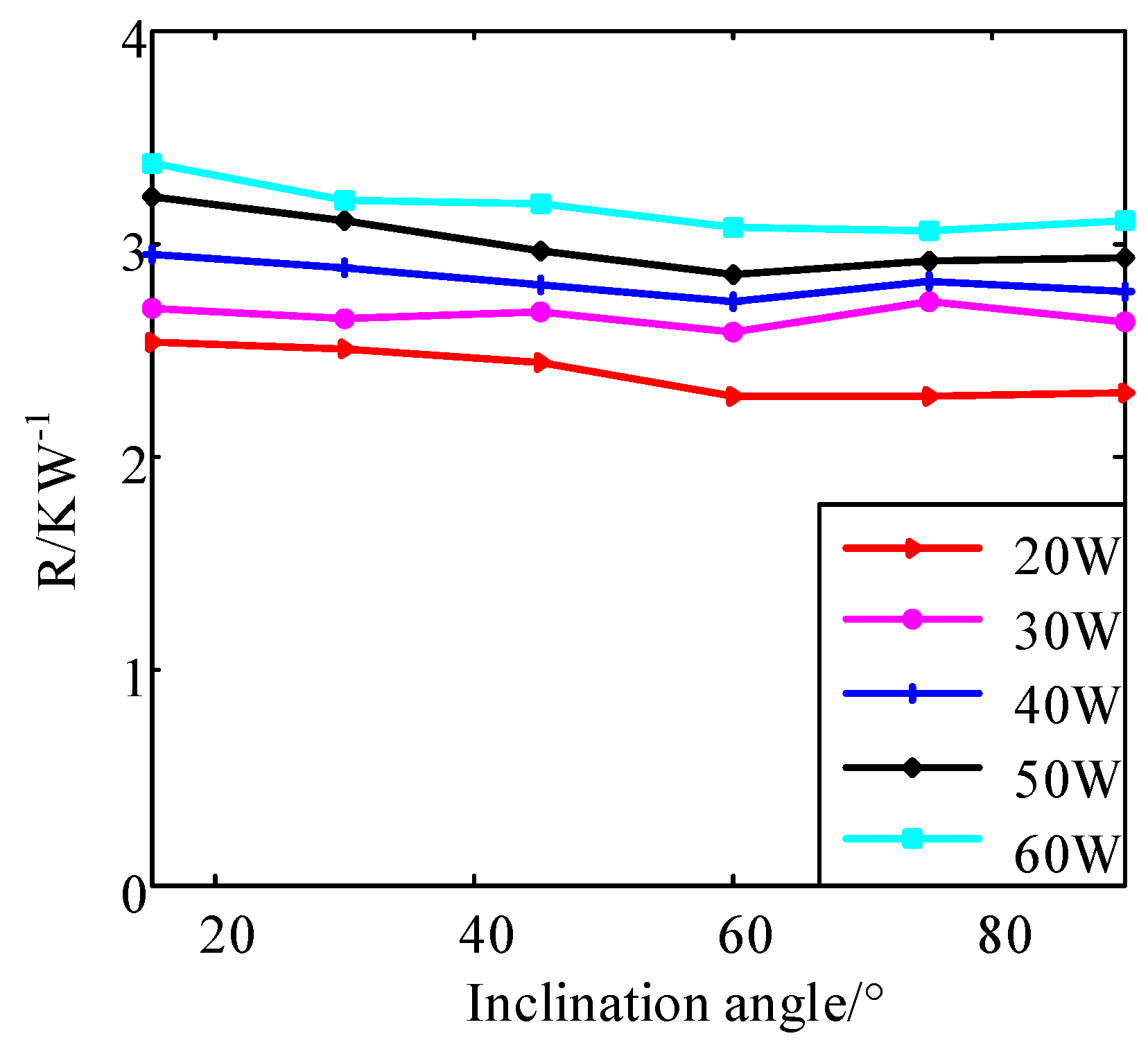Effect of the Inclination Angle on the Steady-State Heat Transfer Performance of a Thermosyphon
Abstract
:1. Introduction
2. Theory
2.1. Actual Heating Area
2.2. Total Thermal Resistance and Areal Thermal Resistance
3. Experiments
4. Results and Discussion
4.1. Variations in the Total Thermal Resistance and Areal Thermal Resistance of the Thermosyphon with Respect to the Inclination Angle
4.2. Variations in the Total Thermal Resistance and Areal Thermal Resistance of the Thermosyphon with Respect to the Heat Transfer Rate
4.3. Derivation and Verification of the Theoretical Formula for the Total Thermal Resistance of the Thermosyphon
5. Conclusions
Author Contributions
Funding
Conflicts of Interest
Nomenclature
| di | inner diameter (m) |
| L | length (m) |
| α | filling rate |
| V | working fluid volume (m3) |
| β | heater length ratio |
| θ | inclination angle (rad) |
| Aθ | actual heating area at inclination (m2) |
| A | heating area (m2) |
| ΔT | temperature difference (K) |
| Q | heat transfer rate (W) |
| R | thermal resistance (KW−1) |
| RA | area thermal resistance (m2KW−1) |
| RS | thermal resistance increment (m2KW−2) |
| RC | constant thermal resistance (m2KW−1) |
References
- Nada, S.A.; El-Ghetany, H.H.; Hussein, H.M.S. Performance of a two-phase closed thermosyphon solar collector with a shell and tube heat exchanger. Appl. Therm. Eng. 2004, 24, 1959–1968. [Google Scholar] [CrossRef]
- Riehl, R.R.; Dutra, T. Development of an experimental loop heat pipe for application in future space missions. Appl. Therm. Eng. 2005, 25, 101–112. [Google Scholar] [CrossRef]
- Li, J.; Wang, D.; Peterson, G.P.B. A Compact Loop Heat Pipe with Flat Square Evaporator for High Power Chip Cooling. IEEE Trans. Compon. Packag. Manuf. Technol. 2011, 1, 519–527. [Google Scholar] [CrossRef]
- Du, J.; Bansal, P.; Huang, B. Simulation model of a greenhouse with a heat-pipe heating system. Appl. Energy 2012, 93, 268–276. [Google Scholar] [CrossRef]
- Singh, R.; Mochizuki, M.; Mashiko, K.; Nguyen, T. Heat pipe based cold energy storage systems for datacenter energy conservation. Energy 2011, 36, 2802–2811. [Google Scholar] [CrossRef]
- Ahmadzadehtalatapeh, M.; Yau, Y.H. The application of heat pipe heat exchangers to improve the air quality and reduce the energy consumption of the air conditioning system in a hospital ward—A full year model simulation. Energy Build. 2011, 43, 2344–2355. [Google Scholar] [CrossRef]
- Noie, S.H.; Heris, S.Z.; Kahani, M.; Nowee, S.M. Heat transfer enhancement using Al2O3/water nanofluid in a two-phase closed thermosyphon. Int. J. Heat Fluid Flow 2009, 30, 700–705. [Google Scholar] [CrossRef]
- Wang, X.; Wang, Y.; Chen, H.; Zhu, Y. A combined CFD/visualization investigation of heat transfer behaviors during geyser boiling in two-phase closed thermosyphon. Int. J. Heat Mass Transf. 2018, 121, 703–714. [Google Scholar] [CrossRef]
- Alizadehdakhel, A.; Rahimi, M.; Alsairafi, A.A. CFD modeling of flow and heat transfer in a thermosyphon. International Commun. Heat Mass Transf. 2010, 37, 312–318. [Google Scholar] [CrossRef]
- Noie, S.H.; Sarmasti Emami, M.R.; Khoshnoodi, M. Effect of Inclination Angle and Filling Ratio on Thermal Performance of a Two-Phase Closed Thermosyphon under Normal Operating Conditions. Heat Transf. Eng. 2007, 28, 365–371. [Google Scholar] [CrossRef]
- Lee, Y.; Mital, U. A two-phase closed thermosyphon. Int. J. Heat Mass Transf. 1972, 15, 1695–1707. [Google Scholar] [CrossRef] [Green Version]
- Noie, S.H. Heat transfer characteristics of a two-phase closed thermosyphon. Appl. Therm. Eng. 2005, 25, 495–506. [Google Scholar] [CrossRef]
- Payakaruk, T.; Terdtoon, P.; Ritthidech, S. Correlations to predict heat transfer characteristics of an inclined closed two-phase thermosyphon at normal operating conditions. Appl. Therm. Eng. 2000, 20, 781–790. [Google Scholar] [CrossRef]
- Wang, C.; Yao, F.; Shi, J.; Wu, L.; Zhang, M. Visualization Study on Thermo-Hydrodynamic Behaviors of a Flat Two-Phase Thermosyphon. Energies 2018, 11, 2295. [Google Scholar] [CrossRef]
- Solomon, A.B.; Roshan, R.; Vincent, W.; Karthikeyan, V.K.; Asirvatham, L.G. Heat transfer performance of an anodized two-phase closed thermosyphon with refrigerant as working fluid. Int. J. Heat Mass Transf. 2015, 82, 521–529. [Google Scholar] [CrossRef]
- Huminic, G.; Huminic, A. Heat transfer characteristics of a two-phase closed thermosyphons using nanofluids. Exp. Therm. Fluid Sci. 2011, 35, 550–557. [Google Scholar] [CrossRef]
- Arya, A.; Sarafraz, M.M.; Shahmiri, S.; Madani, S.A.H.; Nikkhah, V.; Nakhjavani, S.M. Thermal performance analysis of a flat heat pipe working with carbon nanotube-water nanofluid for cooling of a high heat flux heater. Heat Mass Transf. 2017, 54, 985–997. [Google Scholar] [CrossRef]
- Lv, L.; Li, J. Effect of charging ratio on thermal performance of a miniaturized two-phase super-heat-spreader. Int. J. Heat Mass Transf. 2017, 104, 489–492. [Google Scholar] [CrossRef]
- Zhao, Z.; Zhang, Y.; Zhang, Y.; Zhou, Y.; Hu, H. Numerical Study on the Transient Thermal Performance of a Two-Phase Closed Thermosyphon. Energies 2018, 11, 1433. [Google Scholar] [CrossRef]
- Alammar, A.A.; Al-Dadah, R.K.; Mahmoud, S.M. Numerical investigation of effect of fill ratio and inclination angle on a thermosiphon heat pipe thermal performance. Appl. Therm. Eng. 2016, 108, 1055–1065. [Google Scholar] [CrossRef]
- Alammar, A.A.; Al-Dadah, R.K.; Mahmoud, S.M. Effect of inclination angle and fill ratio on geyser boiling phenomena in a two-phase closed thermosiphon—Experimental investigation. Energy Convers. Manag. 2018, 156, 150–166. [Google Scholar] [CrossRef]
- Moffat, R.J. Describing the uncertainties in experimental results. Exp. Therm. Fluid Sci. 1988, 1, 3–17. [Google Scholar] [CrossRef] [Green Version]
- Sarafraz, M.M.; Pourmehran, O.; Yang, B.; Arjomandi, M. Assessment of the thermal performance of a thermosyphon heat pipe using zirconia-acetone nanofluids. Renew. Energy 2019, 136, 884–895. [Google Scholar] [CrossRef]










| Case | Range of Parameters | Calculation Equation |
|---|---|---|
| (a) | 0 < α < 0.5, θ2 ≤ θ ≤ π/2, 0 < β < β1 | Equation (7) |
| (b) | 0 < α < 0.5, θ2 ≤ θ ≤ π/2, β1 ≤ β < β2 | Equation (9) |
| (c) | 0 < α < 0.5, θ2 ≤ θ ≤ π/2, β2 ≤ β < 1 | Equation (11) |
| (d) | 0 < α < 0.5, θ1 ≤ θ ≤ θ2, 0 ≤ β < β3 | Equation (15) |
| (e) | 0 < α < 0.5, θ1 ≤ θ ≤ θ2, β3 ≤ β < 1 | Equation (17) |
| (f) | 0 < α < 0.5, 0 ≤ θ ≤ θ1, 0 ≤ β < 1 | Equation (21) |
| (g) | 0.5 ≤ α ≤ 1, θ4 ≤ θ ≤ π/2, 0 ≤ β < β4 | Equation (28) |
| (h) | 0.5 ≤ α ≤ 1, θ4 ≤ θ ≤ π/2, β4 ≤ β < β5 | Equation (30) |
| (i) | 0.5 ≤ α ≤ 1, θ4 ≤ θ ≤ π/2, β5 ≤ β < 1 | Equation (32) |
| (j) | 0.5 ≤ α ≤ 1, θ3 ≤ θ ≤ θ4, 0 ≤ β < 1 − β6 | Equation (36) |
| (k) | 0.5 ≤ α ≤ 1, θ3 ≤ θ ≤ θ4, 1 − β6 ≤ β < 1 | Equation (38) |
| (l) | 0.5 ≤ α ≤ 1, 0 ≤ θ ≤ θ3, 0 ≤ β < 1 | Equation (42) |
| Parameter | Valve |
|---|---|
| Body material | Copper |
| Working fluid | Ethanol |
| Length (mm) | 220 |
| Evaporation length (mm) | 50 |
| Adiabatic length (mm) | 90 |
| Condenser length (mm) | 80 |
| Inner diameter (mm) | 7.6 |
| Outer diameter (mm) | 10 |
| Filling ratio (%) | 22.7 |
| Inclination Angle (°) | Heat Transfer Rate (W) | Predictive (K/W) | Experimental (K/W) |
|---|---|---|---|
| 15 | 20 | 2.597 | 2.542 |
| 15 | 30 | 2.81 | 2.689 |
| 15 | 40 | 3.023 | 2.954 |
| 15 | 50 | 3.236 | 3.217 |
| 15 | 60 | 3.449 | 3.369 |
| 30 | 20 | 2.466 | 2.504 |
| 30 | 30 | 2.668 | 2.65 |
| 30 | 40 | 2.87 | 2.89 |
| 30 | 50 | 3.072 | 3.103 |
| 30 | 60 | 3.274 | 3.207 |
| 45 | 20 | 2.421 | 2.438 |
| 45 | 30 | 2.62 | 2.683 |
| 45 | 40 | 2.818 | 2.808 |
| 45 | 50 | 3.017 | 2.97 |
| 45 | 60 | 3.215 | 3.192 |
| 60 | 20 | 2.396 | 2.279 |
| 60 | 30 | 2.592 | 2.586 |
| 60 | 40 | 2.789 | 2.721 |
| 60 | 50 | 2.985 | 2.847 |
| 60 | 60 | 3.182 | 3.072 |
| 75 | 20 | 2.378 | 2.292 |
| 75 | 30 | 2.573 | 2.719 |
| 75 | 40 | 2.768 | 2.815 |
| 75 | 50 | 2.963 | 2.92 |
| 75 | 60 | 3.158 | 3.061 |
© 2019 by the authors. Licensee MDPI, Basel, Switzerland. This article is an open access article distributed under the terms and conditions of the Creative Commons Attribution (CC BY) license (http://creativecommons.org/licenses/by/4.0/).
Share and Cite
Wu, Y.; Zhang, Z.; Li, W.; Xu, D. Effect of the Inclination Angle on the Steady-State Heat Transfer Performance of a Thermosyphon. Appl. Sci. 2019, 9, 3324. https://doi.org/10.3390/app9163324
Wu Y, Zhang Z, Li W, Xu D. Effect of the Inclination Angle on the Steady-State Heat Transfer Performance of a Thermosyphon. Applied Sciences. 2019; 9(16):3324. https://doi.org/10.3390/app9163324
Chicago/Turabian StyleWu, Yafeng, Zhe Zhang, Wenbin Li, and Daochun Xu. 2019. "Effect of the Inclination Angle on the Steady-State Heat Transfer Performance of a Thermosyphon" Applied Sciences 9, no. 16: 3324. https://doi.org/10.3390/app9163324




